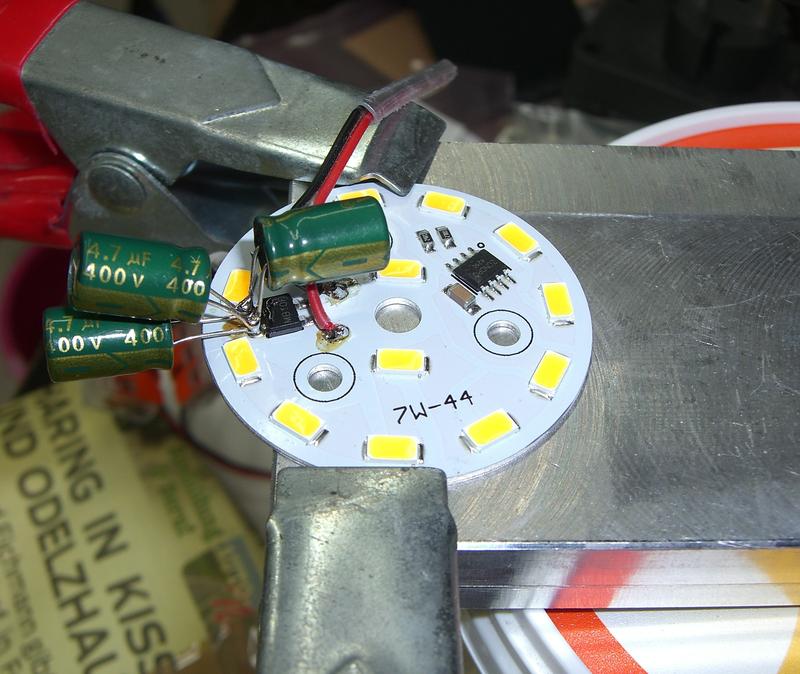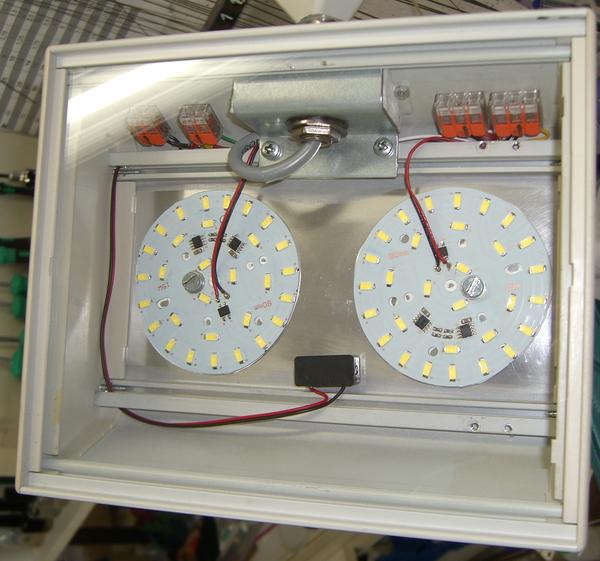Julian Holtz
Enlightened
Dear friends,
just for giggles, I purchased a DirectAC LED module some time ago from this vendor.
http://www.ebay.de/itm/Direct-AC-22...hash=item35fd260b52:m:mxO2KL7R66dZNKBogeyjqzw
Then I got the idea about driving it with DC to get rid of the flicker which was very clearly present at 230V AC direct drive. When I waved my hand above it, I saw the typical flicker effect.
I saw that there is a rectifier directly at the beginning, so I soldered 3 pieces of 4.7uF 400V capacitors I had at hand to the output contacts.

The flicker was not noticable any more! Of course, adding a capacitor somehow defies the purpose of a solid state LED module. But only needing a capacitor instead of a driver has its merits:
- cheaper, caps can be salvaged from power supplies and such
- can be made bigger so that capacity loss is acceptable to some extent, thus ensuring a longer application life
- can be moved away from the LED module, so that it will not be heated, thus ensuring longer life
- film capacitors could maybe be used, with a potentially huge lifespan
- if caps fail, the LED module will still work, only with flicker, no worse than normal.
Some russians arrived at the same idea I just found out:
http://ledway.ru/topic8049.html
They see the problem that the module no runs at a higher effective voltage, thus the output increases, so they want to add current limiting resistors.
Provided I will find my IR thermometer, I will make a temperature comparison of running it with and without caps, and compare.
But for now, I have to say that this is a very fine option of getting to run a rather large LED module, flicker-free, with minimum cost and complication.
What do you think about it?
just for giggles, I purchased a DirectAC LED module some time ago from this vendor.
http://www.ebay.de/itm/Direct-AC-22...hash=item35fd260b52:m:mxO2KL7R66dZNKBogeyjqzw
Then I got the idea about driving it with DC to get rid of the flicker which was very clearly present at 230V AC direct drive. When I waved my hand above it, I saw the typical flicker effect.
I saw that there is a rectifier directly at the beginning, so I soldered 3 pieces of 4.7uF 400V capacitors I had at hand to the output contacts.

The flicker was not noticable any more! Of course, adding a capacitor somehow defies the purpose of a solid state LED module. But only needing a capacitor instead of a driver has its merits:
- cheaper, caps can be salvaged from power supplies and such
- can be made bigger so that capacity loss is acceptable to some extent, thus ensuring a longer application life
- can be moved away from the LED module, so that it will not be heated, thus ensuring longer life
- film capacitors could maybe be used, with a potentially huge lifespan
- if caps fail, the LED module will still work, only with flicker, no worse than normal.
Some russians arrived at the same idea I just found out:
http://ledway.ru/topic8049.html
They see the problem that the module no runs at a higher effective voltage, thus the output increases, so they want to add current limiting resistors.
Provided I will find my IR thermometer, I will make a temperature comparison of running it with and without caps, and compare.
But for now, I have to say that this is a very fine option of getting to run a rather large LED module, flicker-free, with minimum cost and complication.
What do you think about it?
Last edited:



